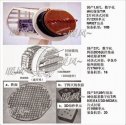Is there any real hard data for any of the Chinese x band airborne aesa radars currently in service? Real annoying they are black boxes with no hard stats such as average/peak power, ranges published let alone brochures/research papers. The one I'm currently interested is the one installed in the J-20 called the type 1475 I believe. If there are any better images of it in circulation than just these two terrible quality images.
You are using an out of date browser. It may not display this or other websites correctly.
You should upgrade or use an alternative browser.
You should upgrade or use an alternative browser.
Chinese Radar Developments - KLJ series and others
- Thread starter indochina
- Start date
Is there any real hard data for any of the Chinese x band airborne aesa radars currently in service? Real annoying they are black boxes with no hard stats such as average/peak power, ranges published let alone brochures/research papers. The one I'm currently interested is the one installed in the J-20 called the type 1475 I believe. If there are any better images of it in circulation than just these two terrible quality images.
No. The infographic illustrates three generations of Chinese AESA radar starting with once again, I repeat, the J-10B, then the J-16 which is second generation, and the J-20 which is third generation. While Gallium is used on the first two, a different Gallium is used on the third. The third generation also features the use of 3D stacked modules.
The real hard number you can get is the number of elements, with 12XX for the J-10B's radar, 1760 elements for the J-16's radar and 1856 elements for the J-20's radar.
The J-16D is a tactical jammer, not an fighter aircraft equipped with a self defense jamming capability.
Possessing a BVR capability is a normal fit out for a contemporary tactical jammer, but being equipped with small self defense jamming pods for the jamming role is very much abnormal when the point of these aircraft types is to do jamming with proper, big jamming pods that tactical jammer aircraft can take the most advantage of.
Your argument about its role only makes sense if you are suggesting the J-16D doesn't follow the same role as the EA-18G, which would be quite a strange position to take, given how you do seem to understand the extent of the airframe modifications the J-16D has, compared to the standard J-16.
As for aircraft that posses and integrated jamming capability with the airframe, naturally anything is possible with money and will. However, the norm for the last couple of decades for tactical jammer aircraft is to have an integrated high end ESM/ELINT capability within the aircraft, while the jamming loadout can change based on each mission, and can be upgraded simply by changing pods as they are developed, rather than an expensive process requiring you to send the entire aircraft into the shop.
As for the shape of J-16Ds wingtip pods, I am not sure why you think its shape is somehow indicative of a dual passive and active role. Everything you described for it is also relevant for ALQ-218 on the EA-18G, and that system as I've repeatedly said is a wholly passive ELINT/ESM one.
View attachment 77411
I will explain to you one more time.
ESM requires much larger antennas to cover a much wider range of frequency lengths. It seems to escape you, as with many, that frequency lengths have a physical size and length. If you want to cover the lower frequencies which search radars and communication antennas use, you need more spaced out or larger antennas.
On the pod, the long strip you see on along the side can serve as the ESM, as well as the upper strakes.
But the tips of the pods themselves are far too small. They are redundant space, and can only be used for something much smaller. They can only be used with the high frequency X-band, and with high frequency comes shorter ranges. The small size means limited receive gain, which points to very short ranges.
Why is there an array? Because its flat and angled. Why is it angled? If the array is facing straight forward it would have increased the RCS of the aircraft so angling it is necessary to reduce its RCS. The fact that it is angled suggests a flat array is present and it is fixed. Like a phase array. If the tip dome is rounded, it would have meant a mechanical antenna on a gimbal with a very wide area of coverage. It is worth noting that in the Khibini pod, there are phase arrays on both ends but there is also a very wide angle lens ahead of the array, which causes the dome to be round. We don't have that here.
So if there is a flat array inside the tip, there are only two possibilities. One is that it is a jammer and the other is that it is a RWR. Both work in the X-band, for close range and for self defense only. The jammer is no bigger than a missile's active radar seeker head and the power would be similar. These would only have resided at the tip of the pod, leaving the rest of the body for ESM.
lcloo
Major
Tam and Bltizo are not speaking on the same frequenzy,
Tam: I want to explain the technicalities of the defensive eletronic pod.
Bltizo: This pod is not that pod. Tactical jamming pod is not same as normal fighters' defensive pots. They have different mission roles.
My take: Tactical jamming pod is for offensive mission role (mission to destroy enemy). Defensive pod is what it is - defensive (to evade enemy's missile attack).
The rest of us: Can we stop this lenghthy debate?
Tam: I want to explain the technicalities of the defensive eletronic pod.
Bltizo: This pod is not that pod. Tactical jamming pod is not same as normal fighters' defensive pots. They have different mission roles.
My take: Tactical jamming pod is for offensive mission role (mission to destroy enemy). Defensive pod is what it is - defensive (to evade enemy's missile attack).
The rest of us: Can we stop this lenghthy debate?
I will explain to you one more time.
ESM requires much larger antennas to cover a much wider range of frequency lengths. It seems to escape you, as with many, that frequency lengths have a physical size and length. If you want to cover the lower frequencies which search radars and communication antennas use, you need more spaced out or larger antennas.
On the pod, the long strip you see on along the side can serve as the ESM, as well as the upper strakes.
But the tips of the pods themselves are far too small. They are redundant space, and can only be used for something much smaller. They can only be used with the high frequency X-band, and with high frequency comes shorter ranges. The small size means limited receive gain, which points to very short ranges.
Why is there an array? Because its flat and angled. Why is it angled? If the array is facing straight forward it would have increased the RCS of the aircraft so angling it is necessary to reduce its RCS. The fact that it is angled suggests a flat array is present and it is fixed. Like a phase array. If the tip dome is rounded, it would have meant a mechanical antenna on a gimbal with a very wide area of coverage. It is worth noting that in the Khibini pod, there are phase arrays on both ends but there is also a very wide angle lens ahead of the array, which causes the dome to be round. We don't have that here.
So if there is a flat array inside the tip, there are only two possibilities. One is that it is a jammer and the other is that it is a RWR. Both work in the X-band, for close range and for self defense only. The jammer is no bigger than a missile's active radar seeker head and the power would be similar. These would only have resided at the tip of the pod, leaving the rest of the body for ESM.
And I will explain to you one more time.
The design and configuration of the J-16Ds wingtip pods and integrated antennae in its airframe is entirely consistent with an ESM/ELINT function expected of a dedicated tactical jammer aircraft, and is almost a perfect parallel in configuration if not design with the EA-18G.
While small wingtip defensive jamming pods exist for other fighter aircraft, it would be a waste of money, development and time to provide a dedicated tactical jammer like J-16D or EA-18G to be equipped with such small and puny wingtip jamming pods when the whole point of such aircraft are to carry far larger and more capable active jamming pods.
But this is getting a drag. I've said all I want, but I do have a a couple of questions that I have because I cannot understand your rationale.
1. Do you believe J-16D is a dedicated tactical jammer aircraft similar to EA-18G?
2. If yes, why do you believe the J-16Ds wingtip pods and its arrangement of airframe antennae are different in role to EA-18Gs wingtip pods and airframe antennae (which are a dedicated ESM/ELINT function, with active jamming provided by removable large jamming pods)?
And I will explain to you one more time.
The design and configuration of the J-16Ds wingtip pods and integrated antennae in its airframe is entirely consistent with an ESM/ELINT function expected of a dedicated tactical jammer aircraft, and is almost a perfect parallel in configuration if not design with the EA-18G.
While small wingtip defensive jamming pods exist for other fighter aircraft, it would be a waste of money, development and time to provide a dedicated tactical jammer like J-16D or EA-18G to be equipped with such small and puny wingtip jamming pods when the whole point of such aircraft are to carry far larger and more capable active jamming pods.
But this is getting a drag. I've said all I want, but I do have a a couple of questions that I have because I cannot understand your rationale.
1. Do you believe J-16D is a dedicated tactical jammer aircraft similar to EA-18G?
2. If yes, why do you believe the J-16Ds wingtip pods and its arrangement of airframe antennae are different in role to EA-18Gs wingtip pods and airframe antennae (which are a dedicated ESM/ELINT function, with active jamming provided by removable large jamming pods)?
Assuming that J-16D seems "Western" and must be similar to the EA-18G is by itself a leap of faith and an unproven assumption.
You keep making Western analogs when the Chinese themselves consistently break that for their convenience and 'Chinese characteristics'.
Fact is, Chinese use of avionics, radars, ESM and ECM is not as Western as you think. For example, if the 052D looks like an Arleigh Burke would you assume its components work similarly to a Burke? There are many components in the 052D that do not work like on the Burke and has no analog on the Burke. There are also components on the Burke that has no analog on the 052D. ZTZ-99 has a turret that looks like a Leopard II and yet it lacks a bustle loader and uses a carousel autoloader like a T-72.
If the aircraft is a dedicated tactical jammer then why can't you believe it should not be capable of cross eye jamming for its own defense? After all the aircraft is a jammer. After all, the Flanker family has relied on cross eye jamming for its own self defense. Why do you think that an EW bent fighter should not have cross eye jamming for its own defense? Do you think air superiority is so guaranteed that these planes do not need any self defense at all? I do not believe that the J-16D is as "dedicated" as you think, and the EA-18G isn't as dedicated either as you think if it is still armed with AIM-120C.
Never mind that I already explained to you that the pod tips would not interfere with the ESM/ELINT function at all. Each pod tip is about the right size that you would expect to be the size of an active radar seeker for an AAM, which has its own functioning radar that can lock into an enemy aircraft. For that matter, a jammer of this size is perfectly sized to spoof an active radar seeker of an AAM or SAM. Spoofers do not overwhelm the target with sheer interference, they instead send a spoof signal that mimics the radar's echo to insert false information about the range and the velocity of the intended target. They do not need to be more powerful than the target radar, the spoofing signal merely needs to have the same amplitude as the true echo signal. I already explained to you that the Khibini pod---used on offensive aircraft like the Su-34----works as an ESM to locate and provide target information for ARMs like the Kh-31 (YJ-91) against radar sites, and yet it is also capable of self defense jamming.
Last edited:
Assuming that J-16D seems "Western" and must be similar to the EA-18G is by itself a leap of faith and an unproven assumption.
You keep making Western analogs when the Chinese themselves consistently break that for their convenience and 'Chinese characteristics'.
Fact is, Chinese use of avionics, radars, ESM and ECM is not as Western as you think. For example, if the 052D looks like an Arleigh Burke would you assume its components work similarly to a Burke? There are many components in the 052D that do not work like on the Burke and has no analog on the Burke. There are also components on the Burke that has no analog on the 052D. ZTZ-99 has a turret that looks like a Leopard II and yet it lacks a bustle loader and uses a carousel autoloader like a T-72.
If the aircraft is a dedicated tactical jammer then why can't you believe it should not be capable of cross eye jamming for its own defense? After all the aircraft is a jammer. After all, the Flanker family has relied on cross eye jamming for its own self defense. Why do you think that an EW bent fighter should not have cross eye jamming for its own defense? Do you think air superiority is so guaranteed that these planes do not need any self defense at all? I do not believe that the J-16D is as "dedicated" as you think, and the EA-18G isn't as dedicated either as you think if it is still armed with AIM-120C.
Never mind that I already explained to you that the pod tips would not interfere with the ESM/ELINT function at all. Each pod tip is about the right size that you would expect to be the size of an active radar seeker for an AAM, which has its own functioning radar that can lock into an enemy aircraft. For that matter, a jammer of this size is perfectly sized to spoof an active radar seeker of an AAM or SAM. Spoofers do not overwhelm the target with sheer interference, they instead send a spoof signal that mimics the radar's echo to insert false information about the range and the velocity of the intended target. They do not need to be more powerful than the target radar, the spoofing signal merely needs to have the same amplitude as the true echo signal. I already explained to you that the Khibini pod---used on offensive aircraft like the Su-34----works as an ESM to locate and provide target information for ARMs like the Kh-31 (YJ-91) against radar sites, and yet it is also capable of self defense jamming.
Continuing here.
How is it a leap of faith to suggest that J-16D is an equivalent to EA-18G?
We already have multiple examples of regular PLA fighter and strike aircraft equipped with ECM pods that serve multiple roles -- J-10s, JH-7/As, J-11B, J-16, have all carried jamming pods that by their own nature, are both active and passive to serve the role of being self defense jamming or having a tactical jammer role embedded fully within the pod itself.
Everything you described is perfectly reasonable if J-16D was not a dedicated tactical jammer, and if it was just a normal fighter aircraft.
However, J-16D is the first PLA fighter aircraft that is a variant with modifications for EW/ECM rather than merely being equipped with pods after the fact.
You yourself have listed the various modifications, ranging from the removal of its gun and IRST, additional airframe antennae, altered radome/nose, and the wingtip pods. These are all modifications entirely consistent with an aircraft intended to be a dedicated tactical jammer, rather than being a fighter merely equipped with a self defense jamming pods or tactical jamming pods where the entire EW/ECM capability (passive and active) has to be contained within a single pod.
For a tactical jammer, the entire aircraft is structurally modified to enhance its EW/ECM role, by enhancing both its passive and active capabilities.
Enhancing its passive capabilities is by virtue of the addition of dedicated antennae and mission computers to provide the aircraft with a much enhanced ELINT/ESM capability.
Enhancing its active capabilities, is usually by providing the aircraft with dedicated large active jamming pods designed to operate in concert with the aircraft's passive ELINT/ESM capability, with the pods usually able to be swapped in and out, modified, and upgraded as new designs enter service (though aircraft like EF-111 also exist).
So -- you ask me, why do I think if an aircraft is a dedicated tactical jammer, why shouldn't it be capable of cross eye jamming for its own defense?
Well, I never said it couldn't be. What I said was that the wingtip pods on J-16D would make the most sense to be for the passive ESM/ELINT role -- because for dedicated tactical jammers, the strength of the aircraft is its innate/baseline potent passive ESM/ELINT capability, while the active jamming capability is to be interchanged between pods depending on the specific mission.
However, for every mission you will require a potent ESM/ELINT capability, which is why the ESM/ELINT subsystems are part of the aircraft's airframe and relatively difficult to remove.
I'm not sure why you are continuously talking about the design of the J-16D's wingtip pod.
The ALQ-218 pod on the EA-18G has all of the same features you've described as J-16D's wingtip pods, yet it is a dedicated ESM/ELINT system, lacking an active jamming capability.
Sure, the design of J-16D's wingtip pods theoretically could possess active and passive functions -- but ALQ-218 demonstrates that J-16D's pod could be purely passive as well.
As for cross eye jamming -- sure, perhaps J-16D could be equipped with smaller active jamming pods on the outboard underwing stations for cross eye jamming, but I expect J-16D to carry large jamming pods (both in service, and under development) as well for its primary mission set. The strength of a tactical jammer is to be equipped with different active pods for different missions, and if for some reason, a particular mission set required the J-16D to possess a self defense jamming role that couldn't be operationally met by its tactical jamming capabilities, then okay, why not.
BUT, if what you said was true, you would be undermining the aircraft's innate ESM/ELINT capabilities to seek to provide an inherent self defense jamming capability.
Whereas for a tactical jammer, possessing a much more potent innate ESM/ELINT capability, while being able to swap out and add active jamming pods would make far more sense, and result in a superior and more flexible EW aircraft.
As for AIM-120 on EA-18Gs -- yes, the EA-18G remains a dedicated tactical jammer.
I use the term "dedicated tactical jammer" to differentiate from the other aircraft you listed, like Flankers, which were "fighter aircraft with jamming capabilities provided by pods".
There is a difference between being a tactical jammer structurally developed and built for the role that possesses some multirole capabilities by virtue of payload, versus a fighter aircraft that possesses some jamming capabilities by virtue of payload.
The EA-18G and J-16D fulfill the former.
Other fighter aircraft fulfill the latter.
Continuing here.
How is it a leap of faith to suggest that J-16D is an equivalent to EA-18G?
We already have multiple examples of regular PLA fighter and strike aircraft equipped with ECM pods that serve multiple roles -- J-10s, JH-7/As, J-11B, J-16, have all carried jamming pods that by their own nature, are both active and passive to serve the role of being self defense jamming or having a tactical jammer role embedded fully within the pod itself.
Everything you described is perfectly reasonable if J-16D was not a dedicated tactical jammer, and if it was just a normal fighter aircraft.
However, J-16D is the first PLA fighter aircraft that is a variant with modifications for EW/ECM rather than merely being equipped with pods after the fact.
You yourself have listed the various modifications, ranging from the removal of its gun and IRST, additional airframe antennae, altered radome/nose, and the wingtip pods. These are all modifications entirely consistent with an aircraft intended to be a dedicated tactical jammer, rather than being a fighter merely equipped with a self defense jamming pods or tactical jamming pods where the entire EW/ECM capability (passive and active) has to be contained within a single pod.
For a tactical jammer, the entire aircraft is structurally modified to enhance its EW/ECM role, by enhancing both its passive and active capabilities.
Enhancing its passive capabilities is by virtue of the addition of dedicated antennae and mission computers to provide the aircraft with a much enhanced ELINT/ESM capability.
Enhancing its active capabilities, is usually by providing the aircraft with dedicated large active jamming pods designed to operate in concert with the aircraft's passive ELINT/ESM capability, with the pods usually able to be swapped in and out, modified, and upgraded as new designs enter service (though aircraft like EF-111 also exist).
So -- you ask me, why do I think if an aircraft is a dedicated tactical jammer, why shouldn't it be capable of cross eye jamming for its own defense?
Well, I never said it couldn't be. What I said was that the wingtip pods on J-16D would make the most sense to be for the passive ESM/ELINT role -- because for dedicated tactical jammers, the strength of the aircraft is its innate/baseline potent passive ESM/ELINT capability, while the active jamming capability is to be interchanged between pods depending on the specific mission.
However, for every mission you will require a potent ESM/ELINT capability, which is why the ESM/ELINT subsystems are part of the aircraft's airframe and relatively difficult to remove.
I'm not sure why you are continuously talking about the design of the J-16D's wingtip pod.
The ALQ-218 pod on the EA-18G has all of the same features you've described as J-16D's wingtip pods, yet it is a dedicated ESM/ELINT system, lacking an active jamming capability.
Sure, the design of J-16D's wingtip pods theoretically could possess active and passive functions -- but ALQ-218 demonstrates that J-16D's pod could be purely passive as well.
As for cross eye jamming -- sure, perhaps J-16D could be equipped with smaller active jamming pods on the outboard underwing stations for cross eye jamming, but I expect J-16D to carry large jamming pods (both in service, and under development) as well for its primary mission set. The strength of a tactical jammer is to be equipped with different active pods for different missions, and if for some reason, a particular mission set required the J-16D to possess a self defense jamming role that couldn't be operationally met by its tactical jamming capabilities, then okay, why not.
BUT, if what you said was true, you would be undermining the aircraft's innate ESM/ELINT capabilities to seek to provide an inherent self defense jamming capability.
Whereas for a tactical jammer, possessing a much more potent innate ESM/ELINT capability, while being able to swap out and add active jamming pods would make far more sense, and result in a superior and more flexible EW aircraft.
As for AIM-120 on EA-18Gs -- yes, the EA-18G remains a dedicated tactical jammer.
I use the term "dedicated tactical jammer" to differentiate from the other aircraft you listed, like Flankers, which were "fighter aircraft with jamming capabilities provided by pods".
There is a difference between being a tactical jammer structurally developed and built for the role that possesses some multirole capabilities by virtue of payload, versus a fighter aircraft that possesses some jamming capabilities by virtue of payload.
The EA-18G and J-16D fulfill the former.
Other fighter aircraft fulfill the latter.
You won't be undermining the pod's ESM/ELINT capabilities because the pod tips are way too small to be used for ESM/ELINT use.
You keep on missing a basic fact about radars is that SIZE matters. The tips are far too small for any array located there to be used offensively.
A small array will only work on higher frequencies like X or K band which tend to be short ranged. A very small receiving area means the range is going to be very limited. We are talking like this small, almost like a missile seeker head.
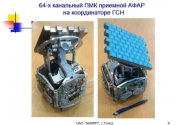
If you put somethings like these at both ends, much of the pod will still be dedicated for ESM antenna. You are making use of the area that can't be used for ESM anyway.
Your self defense jammer only needs to be as big as the missile seeker radar it seeks to jam.
A plane that is a "dedicated" jammer does not need a large honking AESA radar on the front. It can go with a much smaller front radar or no radar at all like the Prowler. You can dedicate the entire nose for EW warfare use. The fact that these planes still have their fighter radars, still carry AAMs tell you otherwise that they are not as "dedicated" as they look.
Phase array on the end of the Khibiny pod.
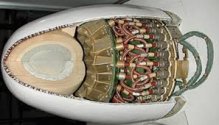
Similar to the J-16's pod, the Khibiny pod also has these long fairings along the side of the pod. The fairings are actually different on each side.
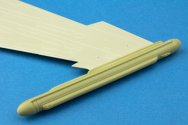
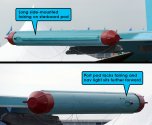
These fairings are what contains the ESM antennas.
The shape and size of the antennas decide what frequency are they working on. The dorsal array on the J-16's pod suggest these particular antenna is meant to work on a very low range. The design also differs from the ALQ-218's "fins".
The ALQ-218 also has this side fairing, just like the Khibiny and J-16 pod. The design of the fins are different from the J-16's dorsal antenna. Its triangular for RCS reduction? Its hard to say if these are real antenna or there to smooth the aerodynamic flow around the pod.
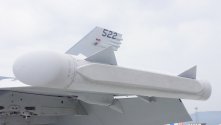
The J-16's dorsal antenna has a sequence and spacing that reminds me of other Chinese ESMs, namely the under dorsal ESM on the Y-8 EW's. This plane will handle wavelengths longer than what the J-16D can handle. Another ESM that it reminds me of is a new ESM array that showed up in recent Type 054A, and is also fitted on two of the earliest frigates. There is likely a Chinese patent on how this works as I don't find any ESM that features these sequential irregular spacing between the horns. The J-16 pod is using proprietary technology in my book.
You won't be undermining the pod's ESM/ELINT capabilities because the pod tips are way too small to be used for ESM/ELINT use.
You keep on missing a basic fact about radars is that SIZE matters. The tips are far too small for any array located there to be used offensively.
A small array will only work on higher frequencies like X or K band which tend to be short ranged. A very small receiving area means the range is going to be very limited. We are talking like this small, almost like a missile seeker head.
View attachment 77424
If you put somethings like these at both ends, much of the pod will still be dedicated for ESM antenna. You are making use of the area that can't be used for ESM anyway.
Why do you think the pod tips are too small to be used for ESM/ELINT?
On ALQ-218, the entire pod is dedicated for ESM/ELINT -- including the front and the back.
I'll refer to two pictures:
First, this one -- you can clearly see on the tip of the pod "do not paint" which is only ever indicated to an area if there is an RF relevant reason for it.
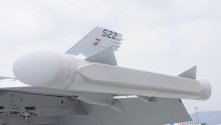
Second, is this cutaway:
You can open the full picture to look at the details of the side ALQ-218 pod -- and the front and the rear tips of the pod (E98) are short baseline interferometer arrays, fully consistent with a passive ESM/ELINT role for the pods.
So -- why do you think the tips of J-16D's pods "are too small" for ESM purposes?

Your self defense jammer only needs to be as big as the missile seeker radar it seeks to jam.
A plane that is a "dedicated" jammer does not need a large honking AESA radar on the front. It can go with a much smaller front radar or no radar at all like the Prowler. You can dedicate the entire nose for EW warfare use. The fact that these planes still have their fighter radars, still carry AAMs tell you otherwise that they are not as "dedicated" as they look.
There is merely an evolution of the role of a dedicated tactical jammer.
Aircraft like EA-18G and J-16D remain dedicated tactical jammers like EA-6B, but feature additional capabilities seen on regular fighters to allow them to operate better in contested airspace.
They remain dedicated tactical jammers, in comparison to aircraft like Su-27SK, Su-30MKK, F-18E/F, J-11B etc.
Phase array on the end of the Khibiny pod.
View attachment 77425
Similar to the J-16's pod, the Khibiny pod also has these long fairings along the side of the pod. The fairings are actually different on each side.
View attachment 77427
View attachment 77426
These fairings are what contains the ESM antennas.
The shape and size of the antennas decide what frequency are they working on. The dorsal array on the J-16's pod suggest these particular antenna is meant to work on a very low range. The design also differs from the ALQ-218's "fins".
The ALQ-218 also has this side fairing, just like the Khibiny and J-16 pod. The design of the fins are different from the J-16's dorsal antenna. Its triangular for RCS reduction? Its hard to say if these are real antenna or there to smooth the aerodynamic flow around the pod.
View attachment 77428
The J-16's dorsal antenna has a sequence and spacing that reminds me of other Chinese ESMs, namely the under dorsal ESM on the Y-8 EW's. This plane will handle wavelengths longer than what the J-16D can handle. Another ESM that it reminds me of is a new ESM array that showed up in recent Type 054A, and is also fitted on two of the earliest frigates. There is likely a Chinese patent on how this works as I don't find any ESM that features these sequential irregular spacing between the horns. The J-16 pod is using proprietary technology in my book.
I've provided you a detailed cutaway of the various subcomponents of ALQ-218 above.
The tip and end of the pod (E98) are short baseline interferometer arrays.
The outwards side rectangular strip on the pod is E100/E101) are mid band short baseline interferometer arrays.
Other aspects of the overall ALQ-218 system is integrated in the aircraft's overall fuselage.
But, I think I've demonstrated pretty clearly a reasonable basis that the entire ALQ-218 pod -- including the front and rear tips -- are relevant for the ESM/ELINT mission.
Given the J-16D's similar configuration of its pod, there is no reason to suspect that its front and rear tips cannot also be for the ESM/ELINT mission, especially in context of the overall logic of seeking to rationalize a tactical jammer's passive ESM/ELINT mission into the aircraft's overall innate structure (including fuselage and long term integrated wingtip pods) and to place its active jamming mission among removable, changeable pods as the mission dictates.
Whether the J-16D's wingtip pods "could" be a general self defense pod is irrelevant to your argument, because the role of those pods has to be considered within the role of J-16D as an aircraft which is as a dedicated tactical jammer aircraft, where retaining an advanced and innate ESM/ELINT role to the aircraft's structure and long term wingtip pods is beneficial for its role.
That, combined with the fact that the ALQ-218's wingtip pods feature a very similar configuration to J-16D's pods, and that the ALQ-218's pods are also wholly dedicated to the ESM/ELINT role as part of the aircraft's overall ESM/ELINT payload, is why I think the most reasonable position to take for the role of J-16D's wingtip pods are for the ESM/ELINT role.
That is a good thing for J-16D.
Having an advanced ESM/ELINT role for the aircraft permanently as standard is very, very good -- because it means the aircraft has the option to carry active jamming pods of various roles and sizes depending on the mission, whether it is escort jamming, stand off jamming, self protection jamming, or a combination of those roles, without requiring the aircraft to be refitted with different ESM/ELINT suites for those different jamming missions.
It also means that the aircraft can carry no active jamming pods (if a mission dictates it), yet retain a massively powerful ESM/ELINT capability that will never leave the aircraft and allows it to support other friendly aircraft in a package or task group with its potent passive sensor capabilities, or use more of its pylons for other non-traditional jamming roles, including but not limited to DEAD and even A2A, both of which would be made significantly more capable by virtue of its ESM/ELINT suite.


